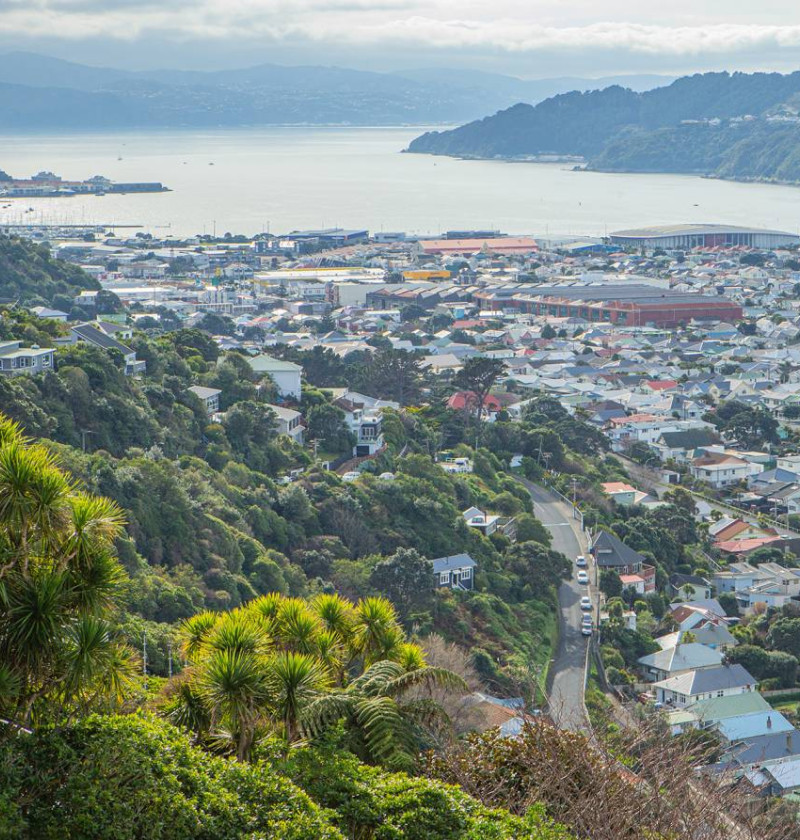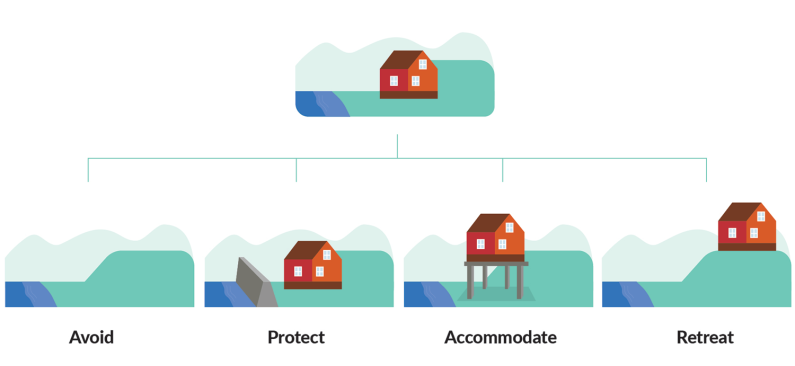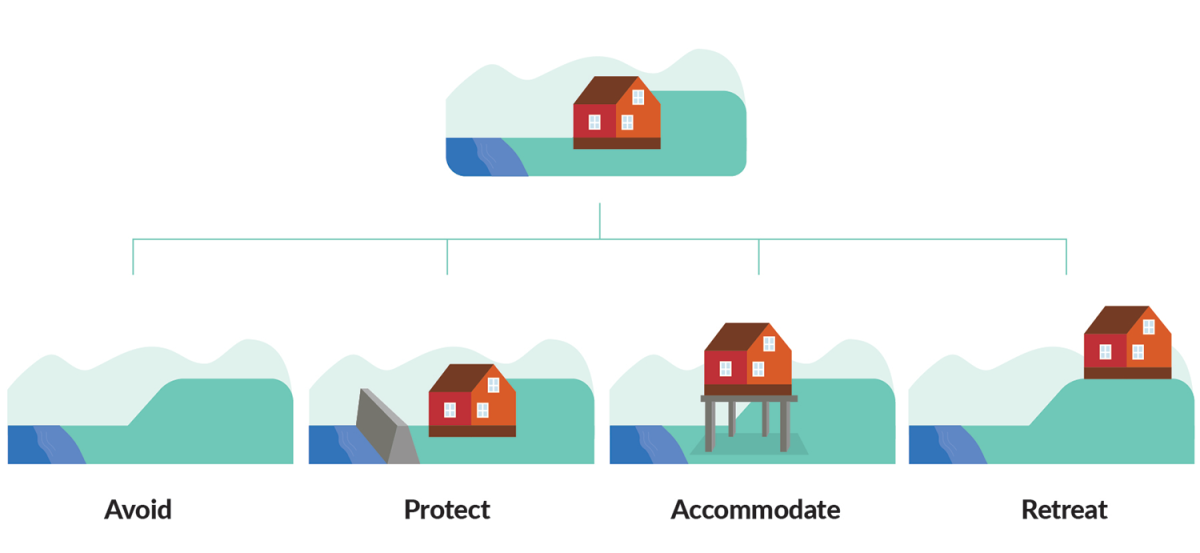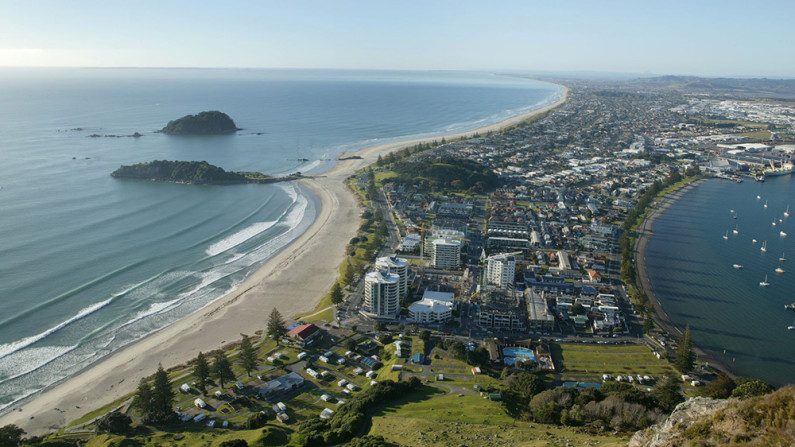Chapter 5 Adaptation options including managed retreat


The plan was published in 2022. Some actions in the plan were amended in January 2025 as part of the Government's response to the Climate Change Commission's national adaptation plan progress report. These updates reflect changes in circumstances since the plan was published, and align with the Government’s climate strategy.
See the response and updated table of actions for more details.
Many of our communities are already experiencing natural hazard events such as flooding, and these are expected to increase over time. The actions in this chapter will support councils, communities, businesses and individuals to consider and understand the range of adaptation options available in their area. These include building resilience at a local property level, as well as managed retreat, where necessary.
H = Human
B = Built
G = Governance
SW = System-wide
HBP = Homes, buildings, places
INF = Infrastructure
EF = Economy and financial system
Although the appropriate location, form and design of new development in the right places will help future-proof our communities, many communities are already under threat from natural hazard events – which will increase over time. Successful adaptation to the impacts of natural hazards and climate change will be vital to the future health and wellbeing of our communities.
In our existing places, people can work together to reduce risk through social networks, nature-based and hard-engineering solutions, through upgrades to existing buildings and infrastructure to withstand more extreme climatic conditions, and by being better prepared. Councils and communities should consider the full range of adaptation options for areas under threat.
These include:
Figure 7 illustrates these options. Avoiding risk is primarily covered by Chapter 4: Driving climate-resilient development in the right locations.
A hybrid approach that uses different adaptation options may be appropriate, and the suite of adaptation options used may change over time. The most appropriate adaptation options will be different for every community or project. A place-based and risk-based approach should ensure the options adopted will meet the specific needs and circumstances of the community. Working with communities to assess these options means that decisions made as to which options will be adopted for a particular community are robust and are well supported and understood by that community.


Councils and communities can consider a range of planning options that can either avoid or delay the need for relocation. Restricting further development or particular uses of land through planning rules – for example, zoning – can prevent further exposure to risk. This approach can also signal that an area may not be viable for development in the longer term. Standards can be set – through rules and consent conditions ̶ to improve the resilience of development in areas exposed to risk. Examples of these types of standards could include minimum floor heights and flood-proofing requirements.
In some highly exposed areas, the risk from natural hazard and climate impacts may become intolerable. Inundation of buildings and infrastructure will start to occur, leading to direct damage and loss of some facilities like roads or other lifeline services, and public open space. In some cases, the risks may reach a threshold where relocation will need to be considered.
Managed retreat is an approach to reduce or eliminate exposure to intolerable risk. It enables people to relocate assets, activities and sites of cultural significance (to Māori and non-Māori), away from areas at risk from climate change and natural hazards.
For communities in areas of high risk, managed retreat is an adaptation option. It is usually not considered in isolation from other options, especially when planning for future rather than current impacts of climate change. In some cases, retreat may be a last resort, and in all cases the costs and benefits will need to be carefully weighed.
See action 5.1: Pass legislation to support managed retreat.
This chapter addresses the following significant risks identified by the National Climate Change Risk Assessment 2020:
The Government has identified a range of objectives for laying the foundations for adaptation, including managed retreat. These are:
Table 4 sets out the objectives that guide this priority area, across the different systems and outcome areas.
| Code | Objective | Explanation |
|---|---|---|
| SW1 | Legislation and institutions are fit for purpose and provide clear roles and responsibilities |
|
| SW2 | Robust information about climate risks and adaptation solutions are accessible to all |
|
| SW4 | Unlocking investment in climate resilience |
|
| NE3 | Support working with nature to build resilience |
|
| HBP1 | Homes and buildings are climate resilient, and meet social and cultural needs |
|
| HBP3 | Māori connections to whenua and places of cultural value are strengthened through partnerships |
|
| HBP4 | Threats to cultural heritage arising from climate change are understood and impacts minimised |
|
| INF1 | Reduce the vulnerability of assets exposed to climate change |
|
| INF3 | Use renewal programmes to improve adaptive capacity |
|
| EF2 | A resilient financial system underpins economic stability and growth. Participants can identify, disclose and manage climate risks |
|
The Government is rolling out a number of major reforms and processes to help New Zealanders respond to existing climate risks, and consider the full range of adaptation options. The resource management reforms are at the centre of that programme of work. These will:
Action 5.1: Pass legislation to support managed retreat will help to implement decisions to retreat once these have been made. This legislation will be developed in partnership with hapū, iwi and Māori and in collaboration with a range of stakeholders that will use it.
Local government is on the front line in preparing for and dealing with climate impacts and risks. To help local government respond to climate risk, action 5.2: The Future for Local Government review will consider changes to local government funding and financing to ensure viability and sustainability, fairness and equity, and maximum wellbeing. The review will also consider when local authority funding should be shared across local government, or with other partners, and when central government co-funding might be justified.
The Government has heard from New Zealanders, and particularly local government, that they are interested in how the new tools and powers being developed might change where costs fall and how costs can be met. To provide greater clarity, the Government will publish the programme of ongoing work across government, which will inform how Aotearoa meets the costs of climate change and invests in resilience (see action 5.5: Publish the programme of work on how Aotearoa meets the costs of climate change and invests in resilience).
Other actions in this plan will also send signals about risk and opportunities, to help manage risks and redirect investment towards resilient projects and products. These include action 3.1: Provide access to the latest climate projections data and action 3.5: Support high-quality implementation of climate-related disclosures and explore expansion. These signals will impact on how adaptation costs will be met and can help to unlock investment.
Action 5.1: Pass legislation to support managed retreat will help to implement decisions to retreat once these have been made. This legislation will be developed in collaboration with a range of stakeholders who will use it, and in partnership with hapū, iwi and Māori, who have particular considerations in relation to whenua Māori and Tiriti considerations.
Legislation for managed retreat will need to consider how to minimise risks to social cohesion, which can be worsened when communities need to relocate. It must consider unique challenges for low-income groups and mobility-compromised and disabled people when faced with having to shift. One way of doing this is to provide certainty about the process and the opportunities for people and communities to engage.
The Government will work with stakeholders and partners to draw lessons from existing situations of high risk. This will make sure the managed retreat legislation delivers what is needed for councils and communities to deal with issues on the ground. While developing the legislation, the Government will consider how current tools can support managed retreat before new legislation (for managed retreat and resource management reform) comes into force.
Timeframe: Years 1–2 (2022–24)
Lead agency: MfE
Relevant portfolio: Climate Change
Primarily supports: Objective SW1
Status: Current
The Government will develop legislation to address the complex technical, legal and financial issues associated with managed retreat as described by the Resource Management Review Panel. This legislation is being progressed through the development of the Climate Adaptation Act.
It will draw lessons from existing situations of high risk to make sure it delivers what is needed for councils and communities dealing with issues on the ground. There will be consideration of how current tools and mechanisms can support managed retreat in advance of new legislation – both for managed retreat and for resource management reform more generally – coming into force.
By the end of 2023, the Government is expecting to introduce the Climate Adaptation Bill, setting out the managed retreat framework.
Timeframe: Year 1 (2022/23)
Lead agency: DIA
Relevant portfolio: Local Government
Primarily supports: Objective SW1
Status: Current
In 2021, the Minister of Local Government started an independent review of the future for local government.
Adaptation will bring new challenges and opportunities to local governance. The system must be equipped for agile, sustainable and proactive decision-making and implementation. The review is likely to include recommendations on what local government does, how it does it and how it pays for it. This will include what should change in funding and financing to ensure viability and sustainability, fairness and equity, and maximum wellbeing. The review will look at when local authority funding obligations should be shared across local government or with other partners, and when central government co-funding might be justified – as is recommended by the Productivity Commission and He Pou a Rangi – Climate Change Commission for large challenges or shocks, and local services with national benefits.
In mid-2023, the Local Government Review Panel will provide the Minister of Local Government with its final report and recommendations for improving the local governance system. Following this, the Government will decide how to respond to the panel’s recommendations.

Coastal communities around Aotearoa are increasingly affected by hazards like coastal inundation (flooding by the sea) and coastal erosion. The Hawke’s Bay region is considered to have one of the highest levels of coastal risk exposure. Natural disasters, storms, coastal erosion and inundation along the region’s 353-kilometre coastline continue to damage property and threaten people’s safety and wellbeing.
In developing the Clifton to Tangoio Coastal Hazards Strategy 2120, the Hawke’s Bay Regional Council, Hastings District Council and Napier City Council have worked with local iwi and coastal community representatives to take a proactive, locally led approach to identifying and responding to coastal hazards over the next 100 years. It has been an opportunity for councils to work together on a complex cross-boundary issue to address community concerns.
The strategy identifies coastline areas that may be affected by coastal hazards over the short to long term, and the risks to public and private property, cultural sites and areas, recreation and infrastructure services. It uses the dynamic adaptive pathways planning (DAPP) framework, which presents adaptation solutions as options in a series of future pathways.
Further work is needed to answer questions about how to share the costs of adaptation solutions, and where to allocate the roles and responsibilities for implementing the strategy.
Timeframe: Year 1 (2022)
Lead agency: DIA
Relevant portfolio: Local Government
Primarily supports: Objective SW2
Status: Current
The Department of Internal Affairs (DIA) is working with the National Emergency Management Agency (NEMA), the West Coast Regional Council, the Buller District Council and local iwi to explore options to increase flood resilience in Westport. This case study will focus on the challenges facing small local authorities and vulnerable communities in funding flood risk management. It will also highlight the challenges of repeat flooding and climate impacts on an existing community that is located on a flood plain with limited flood defences in place. The case study below describes the current situation in Westport.
In June 2022, ministers will receive a strategic business case from the Buller District Council and West Coast Regional Council on a package of flood resilience options to reduce flood risk in Westport.
Timeframe: Years 1–2 (2022–23)
Lead agency: Treasury
Relevant portfolios: Finance; Toka Tū Ake EQC
Primarily supports: Objective EF2
Status: Current
Insurance supports New Zealanders’ resilience to extreme weather events by facilitating recovery. It does so by paying out for losses and reducing the risk that the Government has to design ad hoc, post-event interventions to help communities recover. Home insurance could also bring other benefits, including signalling risk through underwriting and pricing, and giving homeowners peace of mind.
Work is underway to increase understanding of the scale and timing of changes to the insurance market arising from greater use of risk-based pricing by insurers and flooding exacerbated by climate change. This work includes exploring options to support access and affordability of flood insurance. The Government intends to develop options that ensure home flood insurance continues to play an appropriate role in supporting community resilience.
How effectively flood risks are managed in Aotearoa, including adapting to the changing climate, will influence the scale and timing of any insurance issues. This work has important links with other risk management and adaptation initiatives to keep communities safe. These initiatives reduce communities’ exposure to flooding by giving them a better understanding of the risk they face, avoiding development in flood-prone locations, and increasing investment in flood protection.
By the end of 2022, the Government will have received advice on flood insurance options and agreed to next steps. Further implementation measures will depend on the Government’s decisions on options.

The Westport community is facing significant challenges in adapting to the effects of flooding and climate change. Severe floods in July 2021 and February 2022 caused widespread damage to homes and infrastructure, and the Buller District Council required central government funding to help with the recovery.
The July 2021 event was the largest direct measurement of a river flow ever recorded in Aotearoa. It flooded over 400 houses, incurred insurance costs of around $56 million, and made it necessary to create a temporary housing area for those who could not return to their homes.
Modelling suggests the Westport community is at high risk of more floods, with climate change expected to increase their frequency and severity. Repeated flooding has heightened community concerns about reducing the risk and protecting assets and livelihoods.
An important adaptation action is investing more in flood risk reduction; every $1 invested in flood protection schemes results in a $6 return on investment. A number of risk reduction initiatives are underway locally: the West Coast Regional Council is developing a flood protection scheme; the combined district plan (Te Tai o Poutini Plan) proposes rezoning land to residential in less flood-prone areas together with minimum floor heights; and a local-level climate risk assessment and climate adaptation plan for the Buller District has been initiated.
Adaptation is complex and can be expensive. Local ability to fund adaptation and flood protection is likely to be a challenge, as many among the population have very low incomes as measured by the socio-economic deprivation index. Meeting these costs may be beyond the financial capacity of the ratepayers and councils.
Central government (through the Department of Internal Affairs and the National Emergency Management Agency) is partnering with local councils and iwi to explore new funding and financing models for co-investing in flood risk reduction and climate adaptation for Westport. This includes looking at how costs could be more equitably shared between central and local government, and between the community, private sector and other asset owners.

Adaptation case studies and pilot projects can:
Timeframe: Year 1 (2022)
Lead agencies: MfE; Treasury
Relevant portfolios: Climate Change; Finance
Primarily supports: Objective SW4
Status: Current
New Zealanders share in the costs of managing natural hazard risk, through their own investment decisions, insurance, rates and taxes. Additional investment from public and private sources must also be facilitated where necessary to respond to the growing risks from climate change.
There are many processes underway that could change how New Zealanders currently share the costs of climate change. These include action 4.5: Reform institutional arrangements for water services, action 5.2: The Future of Local Government review and action 5.4: Develop options for home flood insurance.
The Government is also considering adaptation criteria for the Climate Emergency Response Fund (CERF) and is launching its Sovereign Green Bond programme (see action 5.15: Public investment in climate change initiatives). In addition, it continues to explore other options to encourage climate-positive, resilient investment. This will build on existing action 3.2: Design and develop risk and resilience and climate adaptation information portals, and action 3.5: support high-quality implementation of climate-related disclosures and explore expansion. It will communicate how this range of work is progressing across government in one place. A dedicated webpage will be kept up to date as work evolves and new actions are developed.
By the end of 2022, a dedicated webpage will be established to provide an update in one place on the range of work progressing across government.
Timeframe: Years 1–3 (2022–24)
Lead agency: Te Waihanga
Relevant portfolio: Infrastructure
Primarily supports: Objective INF3
Status: Current
Te Waihanga will scope the impact (including of costs, benefits and regulations) of a standard or code for resilient infrastructure.
This action will focus on:
If a standard or code proceeds, it would draw on international leading practice, the guidance for assessing impacts on physical assets and the services they provide (Action 3.8), and the general data, tools and guidance that will be part of the system-wide actions.
By 2024, stakeholder feedback on a resilience standard or code will have been received.
Timeframe: Years 1–4 (2022–26)
Lead agencies: HUD; MBIE
Relevant portfolios: Housing; Building and Construction
Primarily supports: Objective HBP1
Status: Current
This action includes five components that build off one another and are necessary to inform regulatory change and other actions in this chapter. These five components are:
Work will start immediately on providing existing information to help people understand adaptation for homes and building. By August 2024, enough data will be available to inform the development of an assessment framework in years 3–4 (2024–26) and regulatory updates.
By 2024, initial research stages will have been scoped and funded and will be underway. Sufficient data will be available to inform the development of an assessment framework in years 3–4 (2024–26).
Timeframe: Years 1–6 (2022–28)
Lead agency: MCH
Relevant portfolio: Culture and Heritage
Primarily supports: Objectives HBP3 and HBP4
Status: Current
Work across government to ensure hapū, iwi and Māori and communities have access to information so they can plan for a changing climate and adapt their cultural assets. Support includes advice, wānanga (conferences, forums, seminars), expert assistance, information sharing and funding advice for kaitiaki to self‑determine adaptation pathways.
This action will be a coordinated cross-government approach, partnering with hapū, iwi and Māori to understand the threats to cultural heritage and to support initiatives to reduce the impact.
This action will also help achieve objective HBP1 (Homes and buildings are climate resilient, and meet social and cultural needs) by adapting and conserving physical structures of cultural value. It also contributes to objective HBP4 (Threats to cultural heritage arising from climate change are understood and impacts minimised) through its focus on taonga of significant value to hapū, iwi and Māori.
By 2024, the Ministry for Culture and Heritage (MCH) will have started working with relevant partners on how improvements can be made to support and access to information on cultural assets to assist kaitiaki to self-determine adaptation pathways.
Timeframe: Years 1–6 (2022–28)
Lead agencies: DOC; MfE
Relevant portfolios: Environment; Conservation
Primarily supports: Objective NE3
Status: Current
To address the climate and biodiversity crises together, the Government will prioritise nature-based solutions in planning and regulations, where possible, for both carbon removals and climate change adaptation. It will also investigate how to best ensure that climate change policy and planning use a biodiversity lens to prioritise nature-based solutions.
By 2024, a framework will be developed, and prioritising of nature-based solutions in regulations and planning will be underway and future implementation measures confirmed.
Timeframe: Years 1–5 (2022–27)
Lead agency: Transpower
Relevant portfolio: Energy and Resources
Primarily supports: Objective INF3
Status: Current
The Transpower Adaptation Plan will outline how Transpower will adapt to climate change through the design, delivery and operation of the national grid. It will address exposed assets and new investment in infrastructure, and consider adaptation in maintenance and development programmes.
Transpower will consider multiple risks to the national grid from climate hazards, including coastal inundation, increased frequency of high-impact flood and wind events, and accelerated erosion.
Timeframe: Years 1–2 (2022–24)
Lead agency: MfE
Relevant portfolio: Environment
Primarily supports: Objective INF1
Status: Current
Coastal inundation and flooding could be a significant risk to existing and closed landfills and contaminated sites across the country. At least 110 closed landfills are vulnerable to sea-level rise.
The Ministry for the Environment (MfE) has helped councils develop a tool to evaluate climate risks for landfills and contaminated sites. This may make it easier for local government to evaluate these risks and support planning to address them.
Timeframe: Years 4–6 (2025–28)
Lead agency: MfE
Relevant portfolio: Environment
Primarily supports: Objective INF1
Status: Current
The liability of legacy landfill remediation generally sits with territorial authorities, which have variable ability to pay, particularly in smaller local government areas. Considering this, the Government has agreed to consider how best to support the funding of remediation.
Access to funding will help to turn risk assessment into risk reduction, and ensure remediation occurs before inundation risks become a reality. The scope of the current Contaminated Sites Remediation Fund does not cover climate impacts.
Timeframe: Years 1–6 (2022–28)
Lead agency: NEMA
Relevant portfolio: Emergency Management
Primarily supports: Objective C3
Status: Current
This action will continue work with central and local government, communities (including rural communities), iwi, organisations and others to support effective, integrated disaster response and recovery. Communities affected by disasters will be assisted by networks that are locally led, regionally coordinated and nationally supported.
Timeframe: Years 1–3 (2022–25)
Lead agency: MfE
Relevant portfolio: Climate Change
Primarily supports: Objective SW2
Status: Current
This will support the development of a ‘green’ taxonomy to identify a common definition of climate and nature-positive investments. This could help guide businesses that are investing in both adaptation and mitigation to protect against greenwashing. If aligned with best practice, it could support greater international investment in Aotearoa New Zealand’s climate-resilient projects, including nature-based solutions.
Timeframe: Years 1–6 (2022–28)
Lead agency: Treasury
Relevant portfolio: Finance
Primarily supports: Objective SW3
Status: Current
The Government is supporting climate change objectives through its approach to the public finance system. This includes the establishment of the Climate Emergency Response Fund (CERF) and the Sovereign Green Bond (Green Bond) programme.
In 2021, the Government established the CERF with an initial $4.5 billion down payment, funded with cash proceeds from the New Zealand Emissions Trading Scheme (NZ ETS).
Government agencies can submit bids to the CERF, primarily through the annual Budget process, to access funding to support climate change initiatives.
In Budget 2022, the CERF was focused on the emissions reduction plan. However, for future Budgets the Government will consider extending the scope of the CERF to fund measures to support climate change adaptation.
In November 2021, the Government announced plans to issue Sovereign Green Bonds (Green Bonds) from 2022 onwards. Green Bonds provide financing for low-emission or environmental projects. Money raised from the Green Bonds will be used to support projects that help reach our climate objectives. Subject to market conditions and progress of establishment activity, final details of the Green Bond programme will be announced mid-2022 and then Green Bonds will be issued in late 2022.
Timeframe: Years 1–2 (2022–24)
Lead agency: HUD
Relevant portfolio: Housing
Primarily supports: Objective HBP2
Status: Proposed
This work will build on indigenous knowledge and new research to produce new data and insights on nature-based solutions such as vegetation (eg, street trees and green roofs) and water elements (eg, open canals and waterways). This includes understanding barriers and identifying ways to accelerate nature-based solutions through changes to urban form and development. Findings will be progressed through action 4.1 Reform the resource management system and action 7.5: Update housing and urban settings. Given the already inequitable distribution of nature-based solutions such as trees and green spaces in our cities, this action will also carefully consider impacts on equity.
This action will help reduce the impact of climate events, such as flooding and heatwaves, in our urban areas to improve outcomes for people, communities and biodiversity. It will also help to ground urban adaptation in mātauranga Māori, and recognise that its outcomes already draw on fundamental Māori values.

Chapter 5 Adaptation options including managed retreat
August 2022
© Ministry for the Environment